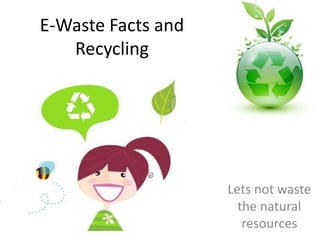
E-Waste Recycling
- 1. E-Waste Facts and Recycling Lets not waste the natural resources
- 2. Why should I Care ??????
- 3. Nearly 50 million tons of e-waste (electronic waste such as cell phones and computers) is created each year around the world. This is enough to fill a line of garbage trucks across half the globe.
- 4. Over 70% of e-waste ends up in China, where much of it is recycled in family-run workshops. Their methods of recycling are often rudimentary and can create serious environmental contaminants and health risks.
- 6. The time taken for glass to decompose naturally isn’t known. However, as we’re still finding pieces of glass made over 3000 years ago, we can only assume it’s a long time!
- 7. Recycling any metals requires 95% less energy and produces 95% less air & water pollution, compared to using virgin ore. e.g Recycling one Kilogram of aluminum saves 8 Kilogram of bauxite (aluminum ore), 4 Kilograms of chemicals and 7 kWh of electricity.
- 8. Circuit boards in computers and other electronics e.g. Switches and liquid crystal displays (LCDs) contain toxic materials like Mercury, Arsenic and Cadmium.
- 9. So what ???? It doesn’t Affect our lives
- 10. Really……………… then keep reading………
- 11. Only 0.002 pounds (or 1 gram) of mercury deposited annually onto a 20-acre lake is enough to make fish unsafe to eat.
- 14. It is estimated that 70% of heavy metals in landfills comes from e-waste. E-waste represents about 2% of the total mass in landfills.
- 15. E-waste also contain valuable substances suitable for reclamation with less raw material including Gold Silver Copper & Palladium
- 26. Found in fluorescent tubes (numerous applications), tilt switches (mechanical doorbells, thermostats) and flat screen monitors. Health effects include sensory impairment, dermatitis, memory loss, and muscle weakness. Environmental effects in animals include death, reduced fertility, slower growth and development.
- 27. Found in lead-acid batteries. Health effects include liver damage, kidney damage, heart damage, eye and throat irritation. When released in to the environment, it can create sulphuric acid. BFRs (Brominated flame retardants): Used as flame retardants in plastics in most electronics. Health effects include impaired development of the nervous system, thyroid problems, liver problems. Environmental effects: similar effects as in animals as humans. PBBs were banned from 1973-1977 on. In PCBs were banned during the 1980's.
- 28. Found in light-sensitive resistors, corrosion-resistant alloys for marine and aviation environments, and nickel-cadmium batteries. The most common form of cadmium is found in Nickel-cadmium rechargeable batteries. These batteries tend to contain between 6-18% cadmium. The sale of Nickel-Cadmium batteries has been banned in the European Union except for medical use. When not properly recycled it can leach into the soil, harming microorganisms and disrupting the soil ecosystem. Exposure is caused by proximity to hazardous waste sites and factories and workers in the metal refining industry. The inhalation of cadmium can cause severe damage to the lungs and is also known to cause kidney damage.
- 29. CRT monitor glass, lead-acid batteries, some formulations of PVC. A typical 15-inch cathode ray tube may contain 1.5 pounds of lead but other CRTs have been estimated as having up to 8 pounds of lead.
- 33. Why is Recycling Important ?
- 34. Why is Recycling Important ? Recycling Saves the Earth Products made from raw materials that came from our natural resources should be recycled so that we can help preserve the environment.
- 35. Why is Recycling Important ? Recycling Saves the Earth Products made from raw materials that came from our natural resources should be recycled so that we can help preserve the environment. Recycling Saves Energy and Natural ResourcesIt takes less energy to process recycled materials than to process virgin materials
- 36. Why is Recycling Important ? Recycling Saves the Earth Products made from raw materials that came from our natural resources should be recycled so that we can help preserve the environment. Recycling Saves Energy and Natural ResourcesIt takes less energy to process recycled materials than to process virgin materials Recycling Helps Mitigate Global Warming and Reduce PollutionBy saving energy in industrial production through recycling, the greenhousegasemissions from factories and industrial plants are lessened and the use of fuels that emit harmful gasses during production is also minimized.
- 37. Why is Recycling Important ? Recycling Saves the Earth Products made from raw materials that came from our natural resources should be recycled so that we can help preserve the environment. Recycling Saves Energy and Natural ResourcesIt takes less energy to process recycled materials than to process virgin materials Recycling Helps Mitigate Global Warming and Reduce PollutionBy saving energy in industrial production through recycling, the greenhousegasemissions from factories and industrial plants are lessened and the use of fuels that emit harmful gasses during production is also minimized. Recycling Reduces Waste Products in LandfillsLandfills are mostly composed of non-biodegradable waste which takes long time to decompose. By recycling, we can lessen the waste materials that are placed into landfills and we are able to make the most out of these materials.
- 38. THANK YOU
